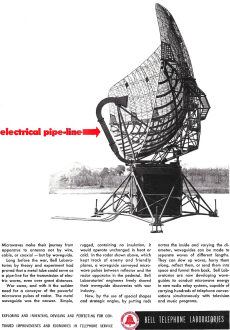Bell Telephone Laboratories - Electrical Pipeline
|
|||||
"Electrical Pipeline" is as apt a layman's description for waveguide as "electrical hose" is for coaxial cable. What would be a good commoner's name for twin lead? "Ladder Line" and "Window Line" are descriptive of the type with open regions between supports, but neither relates to a water analogy that would be familiar to Joe Six−Pack. I'm open to suggestions. Module 11 of the Navy Electricity and Electronics Training Series (NEETS), entitled "Microwave Principles," does a very nice job introducing and explaining how waveguide works. It discusses rectangular, elliptical, and circular waveguide. Bell Telephone Laboratories, which was responsible for some of the most profound and world-shaping innovations of the 20th Century, pioneered the use of waveguide in commercial telecommunications systems. This promotion appeared in a 1946 issue of Radio−Craft magazine. Bell Telephone Laboratories - Electrical Pipeline
Long before the war, Bell laboratories by theory and experiment had proved that a metal tube could serve as a pipe-line for the transmission of electric waves, even over great distances. War came, and with it the sudden need for a conveyor of the powerful microwave pulses of radar. The metal waveguide was the answer. Simple, rugged, containing no insulation, it would operate unchanged in heat or cold. In the radar shown above, which kept track of enemy and friendly planes, a waveguide conveyed microwave pulses between reflector and the radar apparatus in the pedestal. Bell laboratories' engineers freely shared their waveguide discoveries with war industry. Now, by the use of special shapes and strategic angles, by putting rods across the inside and varying the diameter, waveguides can be made to separate waves of different lengths. They can slow up waves, hurry them along, reflect them, or send them into space and funnel them back. Bell laboratories are now developing waveguides to conduct microwave energy in new radio relay systems, capable of carrying hundreds of telephone conversations simultaneously with television and music programs. Bell Telephone Laboratories Exploring and Inventing, Devising and Perfecting for Continued Improvement and Economies in Telephone Service
Posted November 4, 2021 |
|||||

